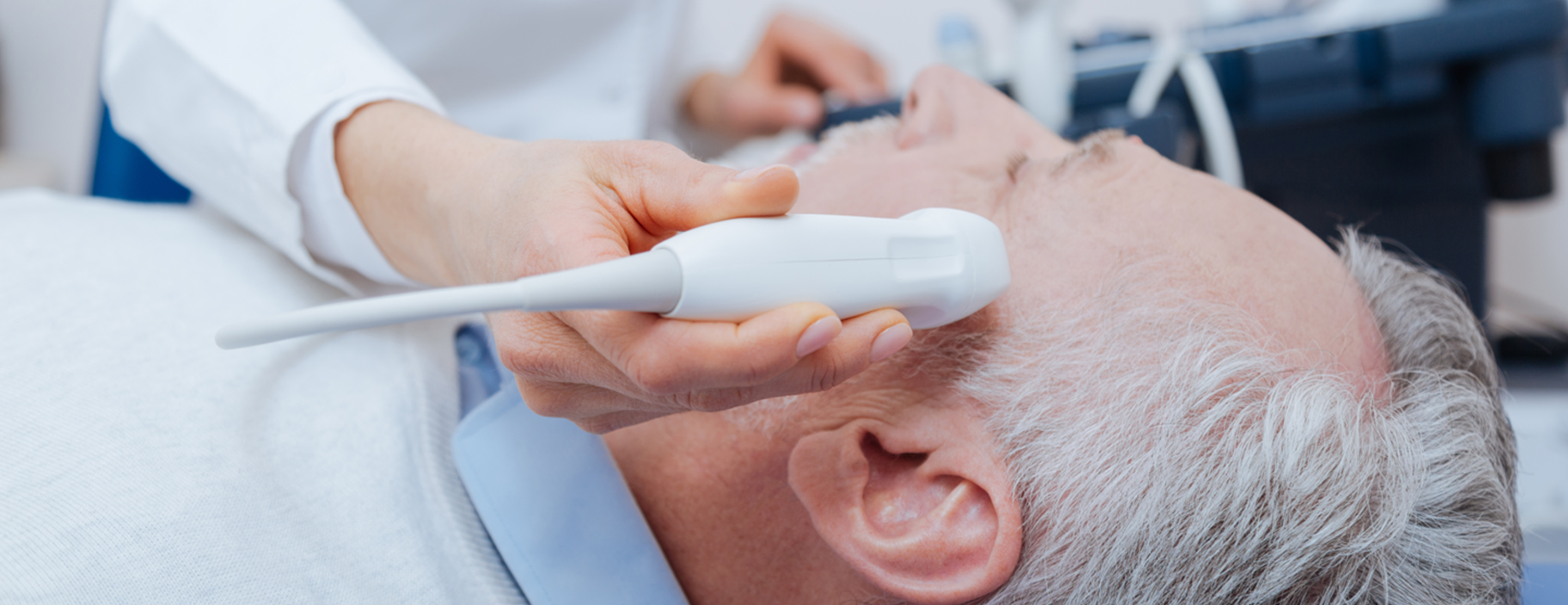
Transcranial Doppler ultrasound
Definition
Transcranial doppler ultrasound (TCD) is a diagnostic test. It measures blood flow to and within the brain.
Alternative Names
Transcranial Doppler ultrasonography; TCD ultrasonography; TCD; Transcranial Doppler study
How the Test is Performed
TCD uses sound waves to create images of the blood flow inside the brain.
This is how the test is performed:
- You will lie on your back on a padded table with your head and neck on a pillow. Your neck is stretched slightly. Or you may sit on a chair.
- The technician applies a water-based gel on your temples and eyelids, under your jaw, and at the base of your neck. The gel helps the sound waves get into your tissues.
- A wand, called a transducer, is moved over the area being tested. The wand sends out sound waves. The sound waves go through your body and bounce off the area being studied (in this case, your brain and blood vessels).
- A computer looks at the pattern that the sound waves create when they bounce back. It creates a picture from the sound waves. The Doppler creates a "swishing" sound, which is the sound of your blood moving through the arteries and veins.
- The test can take 30 minutes to 1 hour to complete.
How to Prepare for the Test
No special preparation is needed for this test. You do not need to change into a medical gown.
Remember to:
- Remove contact lenses before the test if you wear them.
- Keep your eyes closed when gel is applied to your eyelids so you don't get it in your eyes.
How the Test will Feel
The gel may feel cold on your skin. You may feel some pressure as the transducer is moved around your head and neck. The pressure should not cause any pain. You may also hear a "whooshing" sound. This is normal.
Why the Test is Performed
The test is done to detect conditions that affect blood flow to the brain:
- Narrowing or blockage of the arteries in the brain
Stroke ortransient ischemic attack (TIA or ministroke)- Bleeding in the space between the brain and the tissues that cover the brain (
subarachnoid hemorrhage ) - Ballooning of a blood vessel in the brain (
cerebral aneurysm ) - Change in pressure inside the skull (intracranial pressure)
Sickle cell anemia , to assess stroke risk
Normal Results
A normal report shows normal blood flow to the brain. There is no narrowing or blockage in the blood vessels leading to and within the brain.
What Abnormal Results Mean
An abnormal result means an artery may be narrowed or something is changing the blood flow in the arteries of the brain.
Risks
There are no risks with having this procedure.
References
Defresne A, Bonhomme V. Multimodal monitoring. In: Prabhakar H, ed. Essentials of Neuroanesthesia. Cambridge, MA: Elsevier Academic Press; 2017:chap 9.
Ellis JA, Yocum GT, Ornstein E, Joshi S. Cerebral and spinal cord blood flow. In: Cottrell JE, Patel P, eds. Cottrell and Patel's Neuroanesthesia. 6th ed. Philadelphia, PA: Elsevier; 2017:chap 2.
Matta B, Czosnyka M. Transcranial doppler ultrasonography in anesthesia and neurosurgery. In: Cotrell JE, Patel P, eds. Cottrell and Patel's Neuroanesthesia. 6th ed. Philadelphia, PA: Elsevier; 2017:chap 7.
Newell DW, Monteith SJ, Alexandrov AV. Diagnostic and therapeutic neurosonology. In: Winn HR, ed. Youmans and Winn Neurological Surgery. 7th ed. Philadelphia, PA: Elsevier; 2017:chap 363.
Sharma D, Prabhakar H. Transcranial Doppler ultrasonography. In: Prabhakar H, ed. Neuromonitoring Techniques. Cambridge, MA: Elsevier Academic Press; 2018:chap 5.
Purkayastha S, Sorond F. Transcranial Doppler ultrasound: technique and application. Semin Neurol. 2012; 32(4):411-420. PMCID: 3902805
Review Date: 02/12/2019
The information provided herein should not be used during any medical emergency or for the diagnosis or treatment of any medical condition. A licensed physician should be consulted for diagnosis and treatment of any and all medical conditions. Call 911 for all medical emergencies. Links to other sites are provided for information only -- they do not constitute endorsements of those other sites. Copyright ©2019 A.D.A.M., Inc., as modified by University of California San Francisco. Any duplication or distribution of the information contained herein is strictly prohibited.
Information developed by A.D.A.M., Inc. regarding tests and test results may not directly correspond with information provided by UCSF Health. Please discuss with your doctor any questions or concerns you may have.





